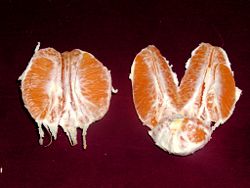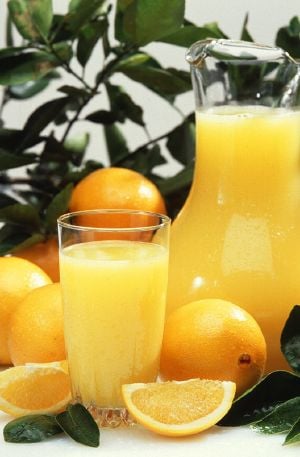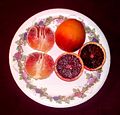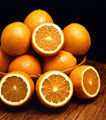Difference between revisions of "Orange (fruit)" - New World Encyclopedia
({{Contracted}}) |
Rick Swarts (talk | contribs) |
||
| Line 17: | Line 17: | ||
| binomial_authority = ([[L.]]) [[Osbeck]] | | binomial_authority = ([[L.]]) [[Osbeck]] | ||
}} | }} | ||
| − | '''Orange'''—specifically, '''sweet orange'''—refers to the [[citrus]] tree ''Citrus sinensis'' ([[Synonymy|syn.]] ''Citrus aurantium'' [[L.]] [[var.]] ''dulcis'' [[L.]], or ''Citrus aurantium'' [[Antoine Risso|Risso]]) and its [[fruit]]. The orange is a [[hybrid]] of ancient cultivated origin, possibly between [[pomelo]] (''Citrus maxima'') and [[tangerine]] (''Citrus reticulata''). It is a small [[Flowering plant | flowering]] [[tree]] growing to about 10 [[metres|m]] tall with [[evergreen]] [[leaf|leaves]], which are arranged alternately, of ovate shape with crenulate margins and 4–10 [[centimetre|cm]] long. The orange [[fruit]] is a [[hesperidium]], a type of [[berry]]. | + | '''Orange'''—specifically, '''sweet orange'''—refers to the [[citrus]] tree ''Citrus sinensis'' ([[Synonymy|syn.]] ''Citrus aurantium'' [[L.]] [[var.]] ''dulcis'' [[L.]], or ''Citrus aurantium'' [[Antoine Risso|Risso]]) and its [[fruit]]. |
| + | |||
| + | ''Citrus'' is a [[genus]] of [[flowering plant]]s in the family [[Rutaceae]] (orange family) and a common name for edible [[fruit]]s of this genus (and sometimes related genera). Citrus fruits are a distinctive berry with the internal parts divided into segments and include [[orange (fruit)|orange]]s, [[lemon]]s, [[lime]]s, [[citron]]s, [[grapefruit]], [[pomelo]]s (pummelo, pommelo), and mandarins (tangerines). The taxonomy of the [[genus]] is complex and the precise number of natural species is unclear, as many of the named species are clonally-propagated hybrids, and there is genetic evidence that even the wild, true-breeding species are of hybrid origin. | ||
| + | |||
| + | |||
| + | The orange is a [[hybrid]] of ancient cultivated origin, possibly between [[pomelo]] (''Citrus maxima'') and [[tangerine]] (''Citrus reticulata''). It is a small [[Flowering plant | flowering]] [[tree]] growing to about 10 [[metres|m]] tall with [[evergreen]] [[leaf|leaves]], which are arranged alternately, of ovate shape with crenulate margins and 4–10 [[centimetre|cm]] long. The orange [[fruit]] is a [[hesperidium]], a type of [[berry]]. | ||
The [[Orange (word)|word "orange"]] ultimately comes from [[Sanskrit]] ''narang'' or [[Tamil language|Tamil]]. The fruit typically has 11 individual pieces inside and in Tamil, the word "Orangu" translates to "6 and 5" implying 11. Oranges originated in southeast [[Asia]], in either [[India]], [[Vietnam]] or southern [[China]]. The fruit of ''Citrus sinensis'' is called ''sweet orange'' to distinguish it from ''Citrus aurantium'', the [[bitter orange]]. | The [[Orange (word)|word "orange"]] ultimately comes from [[Sanskrit]] ''narang'' or [[Tamil language|Tamil]]. The fruit typically has 11 individual pieces inside and in Tamil, the word "Orangu" translates to "6 and 5" implying 11. Oranges originated in southeast [[Asia]], in either [[India]], [[Vietnam]] or southern [[China]]. The fruit of ''Citrus sinensis'' is called ''sweet orange'' to distinguish it from ''Citrus aurantium'', the [[bitter orange]]. | ||
| Line 24: | Line 29: | ||
==Fruit== | ==Fruit== | ||
All citrus trees are of the single genus ''Citrus'', and remain largely interbreedable; that is, there is only one "superspecies" which includes [[lemon]]s, [[lime (fruit)|lime]]s and oranges. Nevertheless, names have been given to the various members of the citrus family, oranges often being referred to as ''Citrus sinensis'' and ''[[bitter orange|Citrus aurantium]]''. Fruits of all members of the genus ''Citrus'' are considered [[berry|berries]] because they have many [[seed]]s, are fleshy and soft, and derive from a single [[ovary (plants)|ovary]]. An orange seed is called a [[pip]]. | All citrus trees are of the single genus ''Citrus'', and remain largely interbreedable; that is, there is only one "superspecies" which includes [[lemon]]s, [[lime (fruit)|lime]]s and oranges. Nevertheless, names have been given to the various members of the citrus family, oranges often being referred to as ''Citrus sinensis'' and ''[[bitter orange|Citrus aurantium]]''. Fruits of all members of the genus ''Citrus'' are considered [[berry|berries]] because they have many [[seed]]s, are fleshy and soft, and derive from a single [[ovary (plants)|ovary]]. An orange seed is called a [[pip]]. | ||
| + | |||
| + | |||
| + | The citrus plants are small [[tree]]s or large [[shrub]]s, reaching 5 to 15 meters tall, with spiny shoots and alternately arranged [[tree#deciduous versus evergreen|evergreen]] [[leaf|leaves]] with an entire margin. The [[flower]]s are solitary or in small [[corymb]]s (a branched cluster of flowers with lower flowers having longer stems). Each flower is 2 to 4 centimeters in diameter, with five (rarely four) white petals and numerous stamens; they are often very strongly scented. | ||
| + | |||
| + | Citrus is likely the most widely planted fruit for direct human consumption in the world (Katz and Weaver 2003). | ||
| + | |||
| + | |||
| + | |||
| + | The distinctive [[fruit]] is a ''hesperidium'', a specialized berry with the internal fleshy parts divided into segments (typically 10 to 16) and surrounded by a separable rind (Katz and Weaver 2003). The herperidium is globose to elongated, 4 to 30 centimeters long, and 4 to 20 centimeters in diameter. The rind is leathery and the segments, or "liths," are filled with pulp [[vesicle]]s. The name herperidium is derived from classical mythology, based on the golden apples grown in the garden of the Hesperides, the daughters of Hesperus (Katz and Weaver 2003). | ||
| + | |||
| + | [[Image:Madarines_white_bg.jpg|thumb|240px|Mandarin oranges or mandarins, with some cultivars also commonly called tangarines]] | ||
| + | |||
| + | The taxonomy of the [[genus]] is complex and the precise number of natural species is unclear, as many of the named species are clonally-propagated hybrids, and there is genetic evidence that even the wild, true-breeding species are of hybrid origin. | ||
| + | |||
| + | Cultivated ''Citrus'' may be derived from as few as three or four ancestral [[species]]. Katz and Weaver (2003) claim that the generally accepted view is that there were three primordial Citrus species—''Citrus medica'' ([[citron]]s), ''Citrus maxima'' ([[pumelo]]s), and ''Citrus reticulata'' ([[mandarin]]s)—and that all other types of citrus rose from single or sequential hybridization events between these species or their offspring. The hybridized types of citrus may or may not be recognized as species according to different taxonomies. Thus, anywhere from 3 to 170 species are recognized, with the commonly used system of Swingle recognizing 16 species (Katz and Weaver 2003). | ||
==Varieties== | ==Varieties== | ||
| Line 118: | Line 138: | ||
==References== | ==References== | ||
| − | + | * Katz, S. H., and W. W. Weaver. 2003. ''Encyclopedia of Food and Culture''. New York: Schribner. ISBN 0684805685. | |
* McPhee, John. ''Oranges'' (1966) - focuses on Florida groves. | * McPhee, John. ''Oranges'' (1966) - focuses on Florida groves. | ||
* Sackman, Douglas Cazaux. ''Orange Empire: California and the Fruits of Eden'' (2005) comprehensive, multidimensional history of citrus industry in California | * Sackman, Douglas Cazaux. ''Orange Empire: California and the Fruits of Eden'' (2005) comprehensive, multidimensional history of citrus industry in California | ||
Revision as of 00:47, 28 July 2007
| Orange | ||||||||||||||||
|---|---|---|---|---|---|---|---|---|---|---|---|---|---|---|---|---|
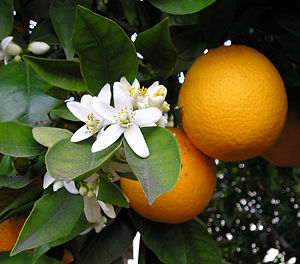 Orange blossoms and oranges on tree
| ||||||||||||||||
| Scientific classification | ||||||||||||||||
| ||||||||||||||||
| Citrus sinensis (L.) Osbeck |
Orange—specifically, sweet orange—refers to the citrus tree Citrus sinensis (syn. Citrus aurantium L. var. dulcis L., or Citrus aurantium Risso) and its fruit.
Citrus is a genus of flowering plants in the family Rutaceae (orange family) and a common name for edible fruits of this genus (and sometimes related genera). Citrus fruits are a distinctive berry with the internal parts divided into segments and include oranges, lemons, limes, citrons, grapefruit, pomelos (pummelo, pommelo), and mandarins (tangerines). The taxonomy of the genus is complex and the precise number of natural species is unclear, as many of the named species are clonally-propagated hybrids, and there is genetic evidence that even the wild, true-breeding species are of hybrid origin.
The orange is a hybrid of ancient cultivated origin, possibly between pomelo (Citrus maxima) and tangerine (Citrus reticulata). It is a small flowering tree growing to about 10 m tall with evergreen leaves, which are arranged alternately, of ovate shape with crenulate margins and 4–10 cm long. The orange fruit is a hesperidium, a type of berry.
The word "orange" ultimately comes from Sanskrit narang or Tamil. The fruit typically has 11 individual pieces inside and in Tamil, the word "Orangu" translates to "6 and 5" implying 11. Oranges originated in southeast Asia, in either India, Vietnam or southern China. The fruit of Citrus sinensis is called sweet orange to distinguish it from Citrus aurantium, the bitter orange. In a number of languages, it is known as a "Chinese apple" (e.g. Dutch Sinaasappel, "China's apple").
Fruit
All citrus trees are of the single genus Citrus, and remain largely interbreedable; that is, there is only one "superspecies" which includes lemons, limes and oranges. Nevertheless, names have been given to the various members of the citrus family, oranges often being referred to as Citrus sinensis and Citrus aurantium. Fruits of all members of the genus Citrus are considered berries because they have many seeds, are fleshy and soft, and derive from a single ovary. An orange seed is called a pip.
The citrus plants are small trees or large shrubs, reaching 5 to 15 meters tall, with spiny shoots and alternately arranged evergreen leaves with an entire margin. The flowers are solitary or in small corymbs (a branched cluster of flowers with lower flowers having longer stems). Each flower is 2 to 4 centimeters in diameter, with five (rarely four) white petals and numerous stamens; they are often very strongly scented.
Citrus is likely the most widely planted fruit for direct human consumption in the world (Katz and Weaver 2003).
The distinctive fruit is a hesperidium, a specialized berry with the internal fleshy parts divided into segments (typically 10 to 16) and surrounded by a separable rind (Katz and Weaver 2003). The herperidium is globose to elongated, 4 to 30 centimeters long, and 4 to 20 centimeters in diameter. The rind is leathery and the segments, or "liths," are filled with pulp vesicles. The name herperidium is derived from classical mythology, based on the golden apples grown in the garden of the Hesperides, the daughters of Hesperus (Katz and Weaver 2003).
The taxonomy of the genus is complex and the precise number of natural species is unclear, as many of the named species are clonally-propagated hybrids, and there is genetic evidence that even the wild, true-breeding species are of hybrid origin.
Cultivated Citrus may be derived from as few as three or four ancestral species. Katz and Weaver (2003) claim that the generally accepted view is that there were three primordial Citrus species—Citrus medica (citrons), Citrus maxima (pumelos), and Citrus reticulata (mandarins)—and that all other types of citrus rose from single or sequential hybridization events between these species or their offspring. The hybridized types of citrus may or may not be recognized as species according to different taxonomies. Thus, anywhere from 3 to 170 species are recognized, with the commonly used system of Swingle recognizing 16 species (Katz and Weaver 2003).
Varieties
Persian orange
The Persian orange, grown widely in southern Europe after its introduction to Italy in the 11th century, was bitter. Sweet oranges brought to Europe in the 15th century from India by Portuguese traders, quickly displaced the bitter, and are now the most common variety of orange cultivated. The sweet orange will grow to different sizes and colours according to local conditions, most commonly with ten carpels, or segments, inside.
Portuguese, Spanish, Arab, and Dutch sailors planted citrus trees along trade routes to prevent scurvy. On his second voyage in 1493, Christopher Columbus brought the seeds of oranges, lemons and citrons to Haiti and the Caribbean. They were introduced in Florida (along with lemons) in 1513 by Spanish explorer Juan Ponce de Leon, and were introduced to Hawaii in 1792.
A single mutation in 1820 in an orchard of sweet oranges planted at a monastery in Brazil yielded the navel orange, also known as the Washington, Riverside or Bahie navel. The mutation causes navel oranges to develop a second orange at the base of the original fruit, opposite the stem. The second orange develops as a conjoined twin in a set of smaller segments embedded within the peel of the larger orange. From the outside, the smaller, undeveloped twin left a formation at the bottom of the fruit, looking similar to the human navel.
Because the mutation left the fruit seedless and therefore sterile, the only means available to cultivate more of this new variety is to graft cuttings onto other varieties of citrus tree. Two such cuttings of the original tree were transplanted[1] to Riverside, California in 1870, which eventually led to worldwide popularity.
Today, navel oranges continue to be produced via cutting and grafting. This does not allow for the usual selective breeding methodologies, and so not only do the navel oranges of today have exactly the same genetic makeup as the original tree, but also, they all can even be considered to be the fruit of that single, now centuries-old tree.
On rare occasions, however, further mutations can lead to new varieties.[2]
Valencia orange
The Valencia or Murcia orange is one of the sweet oranges used for juice extraction. It is a late-season fruit, and therefore a popular variety when the navel oranges are out of season. For this reason, the orange was chosen to be the official mascot of the 1982 FIFA World Cup, which was held in Spain. The mascot was called "Naranjito" ("little orange"), and wore the colours of the Spanish soccer team uniform.
Blood orange
The blood orange has streaks of red in the fruit, and the juice is often a dark burgundy colour. The fruit has found a niche as an interesting ingredient variation on traditional Seville marmalade, with its striking red streaks and distinct flavour. The scarlet navel is a variety with the same diploid mutation as the navel orange.
Production
| Orange, raw, Florida Nutritional value per 100 g | ||||||||||||||||||||||||||||||||||
|---|---|---|---|---|---|---|---|---|---|---|---|---|---|---|---|---|---|---|---|---|---|---|---|---|---|---|---|---|---|---|---|---|---|---|
| Energy 50 kcal 190 kJ | ||||||||||||||||||||||||||||||||||
| ||||||||||||||||||||||||||||||||||
| Percentages are relative to US recommendations for adults. Source: USDA Nutrient database | ||||||||||||||||||||||||||||||||||
According to FAOSTAT, the top producers of oranges (in tonnes) in 2005 were:
| 1. | Brazil | 17,804,600 |
| 2. | USA | 8,393,276 |
| 3. | Mexico | 4,112,711 |
| 4. | India | 3,100,000 |
| 5. | China | 2,412,000 |
| 6. | Spain | 2,294,600 |
| 7. | Italy | 2,201,025 |
| 8. | Iran | 1,900,000 |
| 9. | Egypt | 1,789,000 |
| 10. | Pakistan | 1,579,900 |
Juice and other products
Oranges are widely grown in warm climates worldwide, and the flavours of oranges vary from sweet to sour. The fruit is commonly peeled and eaten fresh, or squeezed for its juice. It has a thick bitter rind that is usually discarded, but can be processed into animal feed by removing water, using pressure and heat. It is also used in certain recipes as flavouring or a garnish. The outer-most layer of the rind is grated or thinly veneered with a tool called a zester, to produce orange zest, popular in cooking because it has a flavour similar to the fleshy inner part of the orange. The white part of the rind, called the pericarp or albedo and including the pith, is a source of pectin and has nearly the same amount of vitamin C as the flesh.
Products made from oranges include:
- Orange juice, one of the commodities traded on the New York Board of Trade. Brazil is the largest producer of orange juice in the world, followed by the USA. It is made by squeezing the fruit on a special instrument called a "juicer" or a "squeezer". The juice is collected in a small tray underneath. This is mainly done in the home, and in industry will be done on a much larger scale
- Sweet orange oil, a by-product of the juice industry produced by pressing the peel. It is used as a flavouring of food and drink and for its fragrance in perfume and aromatherapy. Sweet orange oil consists of about 90% d-Limonene, a solvent used in various household chemicals, such as to condition wooden furniture, and along with other citrus oils in grease removal and as a hand-cleansing agent. It is an efficient cleaning agent which is environmentally friendly, and much less toxic than petroleum distillates. It also smells more pleasant than other cleaning agents.
- The orange blossom, which is the state flower of Florida, is traditionally associated with good fortune, and was popular in bridal bouquets and head wreaths for weddings for some time. The petals of orange blossom can also be made into a delicately citrus-scented version of rosewater. Orange blossom water is a common part of Middle Eastern cuisine. The orange blossom gives its touristic nickname to the Costa del Azahar ("Orange-blossom coast"), the Valencia seaboard.
- In Spain, fallen blossoms are dried and then used to make tea.
- Orange blossom honey, or actually citrus honey, is produced by putting beehives in the citrus groves during bloom, which also pollinates seeded citrus varieties. Orange blossom honey is highly prized, and tastes much like orange.
- Marmalade, a conserve usually made with Seville oranges. All parts of the orange are used to make marmalade: the pith and pips are separated, and typically placed in a muslin bag where they are boiled in the juice (and sliced peel) to extract their pectin, aiding the setting process.
- Orange peel is used by gardeners as a slug repellent.
Since oranges are susceptible to frost damage, growers commonly use sprinklers to coat them with ice when temperatures go below freezing. This practice protects the crops by regulating temperature.
Etymology
Orange derives from Sanskrit nāraṅgaḥ "orange tree", but another explanation tries to establish a link to a Dravidian root meaning "fragrant". Compare Tamil narandam [நரந்தம்] "bitter orange", nagarukam [நாகருகம்] "sweet orange" and nari [நாரி] "fragrance". The Sanskrit or Dravidian word was borrowed into European languages through Persian nārang, Armenian nārinj, Arabic nāranj, (Spanish naranja and Portuguese laranja), Late Latin arangia, Italian arancia or arancio, and Old French orenge, in chronological order. The first appearance in English dates from the 14th century. The forms starting with n- are older; this initial n- may have been mistaken as part of the indefinite article, in languages with articles ending with an -n sound (e.g., in French une norenge may have been taken as une orenge). The name of the colour is derived from the fruit, first appearing in this sense in 1542.
Some languages have different words for the bitter and the sweet orange, such as Modern Greek nerantzi and portokali ("Portuguese"), respectively. Or in Persian, the words are narang and porteghal (Portugal), in the same order. The reason is that the sweet orange was brought from China or India to Europe during the 15th century by the Portuguese. For the same reason, some languages refer to it as Applesin (or variants), which means "Apple from China", while the bitter orange was introduced through Persia.
Storage
Oranges should be stored in the warmest part of the refrigerator. They can normally be stored for about 2 weeks. [3]
Gallery
Picture of a Cara Cara orange (left) with a pink grapefruit for comparison of size and colour.
- Coldsunday.jpg
Icy orange crop
Oranges in popular culture
- Outspan, a branch of Fyffes, had three "motorized oranges" built in 1972, with bits from a mini, in order to promote their fruit.
ReferencesISBN links support NWE through referral fees
- Katz, S. H., and W. W. Weaver. 2003. Encyclopedia of Food and Culture. New York: Schribner. ISBN 0684805685.
- McPhee, John. Oranges (1966) - focuses on Florida groves.
- Sackman, Douglas Cazaux. Orange Empire: California and the Fruits of Eden (2005) comprehensive, multidimensional history of citrus industry in California
- Train, John. Oranges (2006)
Footnotes
Credits
New World Encyclopedia writers and editors rewrote and completed the Wikipedia article in accordance with New World Encyclopedia standards. This article abides by terms of the Creative Commons CC-by-sa 3.0 License (CC-by-sa), which may be used and disseminated with proper attribution. Credit is due under the terms of this license that can reference both the New World Encyclopedia contributors and the selfless volunteer contributors of the Wikimedia Foundation. To cite this article click here for a list of acceptable citing formats.The history of earlier contributions by wikipedians is accessible to researchers here:
The history of this article since it was imported to New World Encyclopedia:
Note: Some restrictions may apply to use of individual images which are separately licensed.

